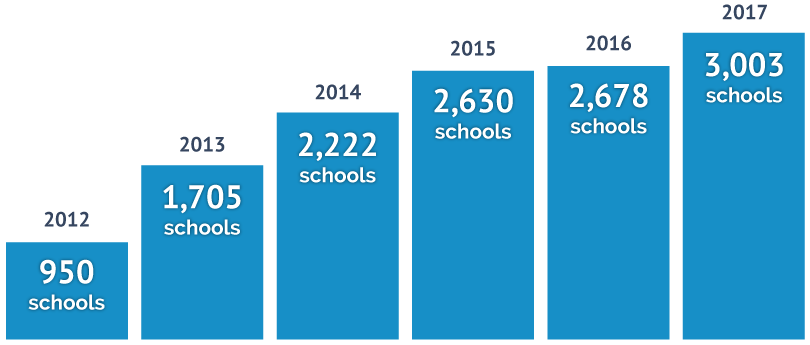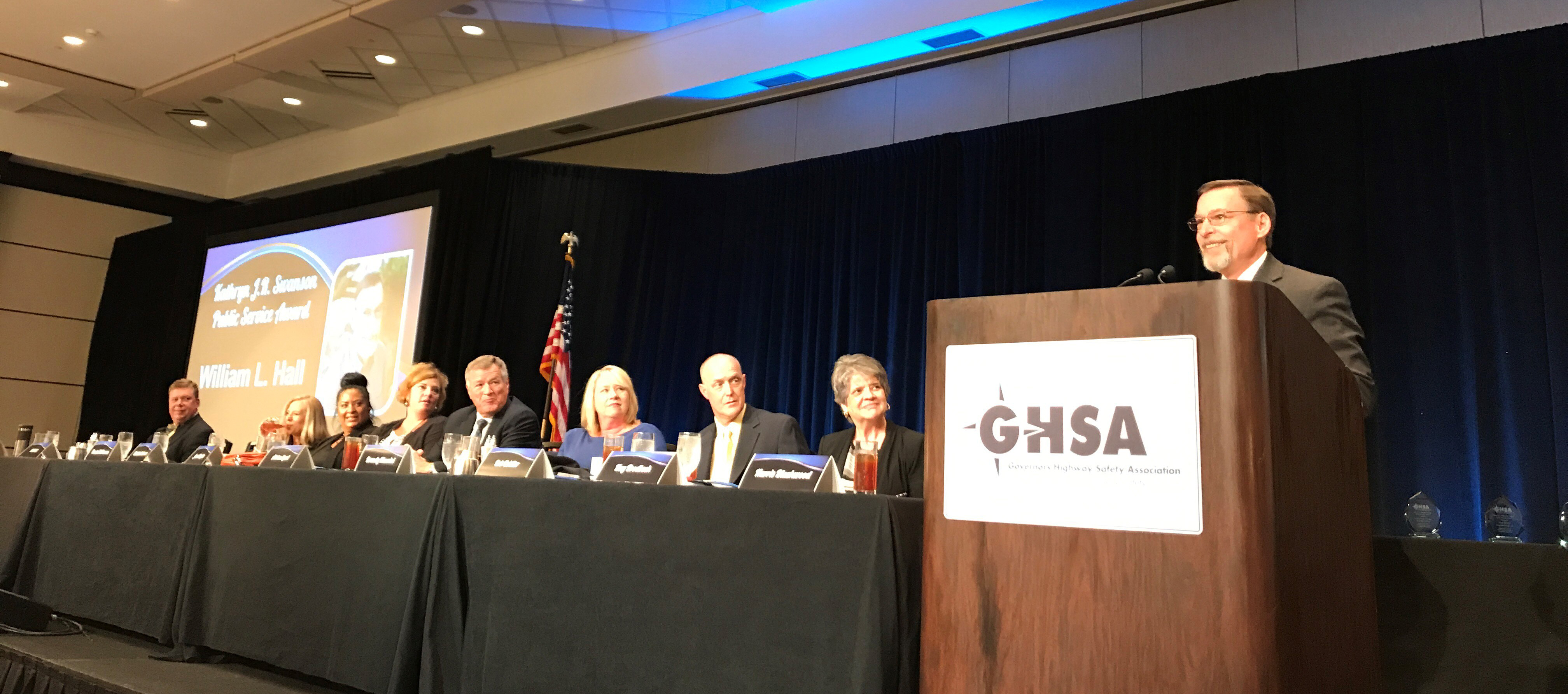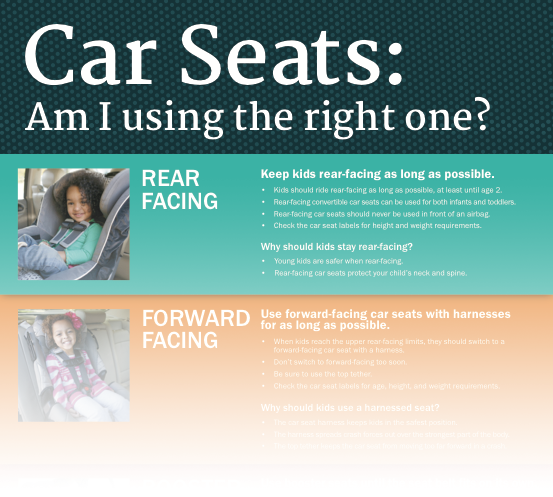News Briefs
Bike and Walk to School Days in 2017 set participation records

Above: Bike to School Day participation, 2012-2017
This year in May, thousands of students and families across the country biked to school as a part of National Bike to School Day, and in October, thousands more walked to school as part of the International Walk to School Day. In all, 3,003 schools registered Bike to School Day events in May, besting the 2016 total of 2,520. And in October, 5,583 schools registered Walk to School Day events, surpassing 2016's record of 4,920.
HSRC welcomes new staff members
HSRC is proud to announce the following additions to our research and project management teams:
Neil Batson

Neil Batson is a business officer for HSRC. He joined HSRC in 2017, but has been employed by UNC-Chapel Hill since 2009. Neil is responsible for monitoring accounts to ensure that accurate and appropriate expenditures are within federal and university guidelines. He manages accounts for awarded projects and is responsible for planning, developing and preparing cost proposals for a variety of federal, state and private agencies, and assists with proposal development. Before joining the staff at UNC, Neil spent many years working in finance in the non-profit world. He currently lives in Carrboro, and stays busy chasing two teenage sons.
Wesley Kumfer

Wes Kumfer joined HSRC in 2017 as a post-doctoral research associate with a focus on crash analysis and safety education. Wes is currently working on a National Cooperative Highway Research Program project investigating systemic issues that affect collisions between motor vehicles and pedestrians. Wes is also working closely with other researchers to augment HSRC’s Road Safety Academy curriculum. Prior to joining HSRC, Wes worked as a postdoctoral research associate and course instructor at Texas Tech University in Lubbock, Texas, as part of the TTU Center for Multidisciplinary Research in Transportation. Wes received his doctorate in civil engineering at TTU and was active in TTU’s Teaching, Learning, and Professional Development Center as a fellow, consultant and workshop facilitator. In his free time, Wes enjoys hiking with his wife and dog.
Taha Saleem

Taha Saleem joined HSRC as a research associate in 2017. His research interests lie mainly in the application of state-of-the-art statistical methods in road safety. Prior to joining HSRC, Taha worked as a post-doctoral research fellow at Ryerson University (Toronto, Canada). His research was on a National Science and Engineering Research Council of Canada-funded project on extracting traffic conflicts from video data and using that as an alternate exposure measure to develop SPFs for intersections. Taha completed his doctorate in civil engineering from Ryerson University in 2016. Taha’s research has so far culminated in over a dozen peer-reviewed journal and conference papers, in addition to three technical reports. Taha also has teaching-related experience including a recent appointment as a sessional lecturer at University of Toronto, where he assisted with the course “The Art of Regression Modelling in Road Safety.”
Recent center highlights
Hall wins GHSA and Safe Kids NC awards

Bill Hall won two awards this year honoring his long career working with HSRC’s occupant protection program. In September, he was honored with the prestigious 2017 Kathryn J.R. Swanson Public Service Award by the Governors Highway Safety Association, and in May, he won the Safe Kids Champion Award at the Safe Kids NC Injury Prevention Conference. (See HSRC in the news below for more details.)
Krista Nordback nominated for Eco-Counter International Award

HSRC senior research associate Krista Nordback was one of three nominees for the Eco-Counter International Awards: the Outstanding Contribution Award. The award was created to honor a remarkable commitment to developing bicycle usage and bicycle monitoring.
HSRC lunch n’ learn webinar explores psychology of novice drivers

HSRC was thrilled to host Dr. Neale Kinnear, principal psychologist at TRL in the United Kingdom, when he presented this June webinar covering his ground-breaking 2013 study, “Understanding how drivers learn to anticipate risk on the road: A laboratory experiment of affective anticipation of road hazards.”
BuckleUpNC releases poster explaining differences in child car seats

HSRC’s BuckleUpNC team, in partnership with the North Carolina Governor’s Highway Safety Program and Safe Kids North Carolina, developed this poster to illustrate how to keep kids safely restrained in the car from birth through the teenage years. It will be distributed throughout the state for use by agencies who serve North Carolina families.
Send an email to info@buckleupnc.org for more information.
HSRC publications and presentations
HSRC researchers and staff regularly publish findings in peer-reviewed journals and present research results at professional meetings and trade conferences in the fields of transportation, safety, research and public health. Below is a list of recent presentations and publications.
To browse additional recent HSRC publications, click here.
Carter, D (September 2016, December 2016, February 2017, May 2017). Traffic Accident Analysis Engineering System [Training course], North Carolina Department of Transportation.
Carter, D. (2017, June). Overview of progress on evaluations conducted to date: Pedestrian and bicycle safety. [Presentation}. Annual Meeting of the Technical Advisory Committee for the Evaluation of Low Cost Safety Improvements Pooled Fund Study, Washington, DC.
Carter, D. (2017, May). Safety evaluation of pedestrian countdown signals: Data challenges in pedestrian studies. [Presentation]. The 5th Urban Street Symposium, Raleigh, NC.
Carter, D.; Nordback, K. & Thomas, L. (2017, May). Urban road safety -- strategies for pedestrian and bicycle crashes. [Workshop]. The 5th Urban Street Symposium, Raleigh, NC.
Curry, A. E., Foss, R. D., & Williams, A. F. (2017, August). Graduated Driver Licensing for Older Novice Drivers: Critical Analysis of the Issues. American Journal of Preventive Medicine. Epub ahead of print.
Foss, R. (2017, June). Applying social psychology: From experiments to social policy. [Invited presentation]. Duke University Psychology Department’s Vertical Integration Program, Durham, NC.
Goodwin, A. (2017, April). Improving teen driver safety through parents of new drivers. Annual North Carolina Driver & Traffic Safety Education Association (NCDTSEA) Conference. Clemmons, NC.
Harkey, D. (2017, April). Rebuilding our infrastructure with technology for improved safety. Panel moderator at the Third Annual Summit of University Transportation Centers for Safety, Washington, DC.
Harkey, David (2017, April). The Changing Face of Road Safety: Expectations for the Future. Carolina Arbors Seminar Series, Durham, NC.
Hummer, J., C.M. Cunningham, R. Srinivasan, S. Warchol, P. Edara, B. Claros & C. Sun (2017, May). Safety Findings at Seven of the First DDI’s in the Country, Presented at the 5th Urban Street Symposium, Raleigh, NC.
Injury Surveillance Workgroup 8 (L. Sandt, member). (2017). Consensus recommendations for pedestrian injury surveillance. Atlanta, GA: Safe States Alliance.
Kirley, B. (2017, March). Survey of North Carolina Motorcyclists. [Presentation]. Lifesavers National Conference on Highway Safety Priorities, Charlotte, NC.
Kothuri, S., Nordback, K., Schrope, A., Phillips, T. & Figliozzi, M. (2017). “Bicycle and pedestrian counts at signalized intersections using existing infrastructure: Opportunities and challenges,” Transportation Research Record, National Academies: Washington, DC, 2644.
LaJeunesse, S. & Validzic, A. (2017, June). Safe Routes to School evaluation resources and best practices. [Webinar]. California Active Transportation Resource Center.
LaJeunesse, S. (2017, April). Vision Zero: What is it, where did it come from, and how does it work? [Invited guest lecture]. University of North Carolina at Chapel Hill, Chapel Hill, NC.
LaJeunesse, S. (2017, May). Vision Zero Approaches that Just Might Work in North Carolina. [PowerPoint slides]. Paper presented at the 5th Urban Street Symposium, Raleigh, NC. Retrieved from https://www.urbanstreet.info/wp-content/uploads/2017/06/PresPDF-S06_LaJeunesse.pdf.
Nordback, K. (2017). "Estimating annual average daily bicycle traffic from short duration counts: method and accuracy," Velo-city 2017, Nijmegen, Netherlands.
Nordback, K. (2017, June 12). Estimating annual average daily bicycle traffic from short duration counts: method and accuracy. [Presentation]. Scientists for Cycling Colloquium, Nijmegen, Netherlands.
Nordback, K. & Kothuri, S. (2017, August 2). Pedestrian and bicycle counting. [Workshop]. ITE Toronto.
Nordback, K., Kothuri, S., Gibson, G., Ferenchak, N. & Marshall, W. (2017, May). Motorist-cyclist crash data needs for safety analysis. [Presentation]. 5th Urban Street Symposium, Raleigh, NC.
Nordback, K., Sellinger, M. & Phillips, T. (2017). Estimating walking and bicycling at the state level. (No. NITC-RR-708). Portland, OR: National Institute for Transportation and Communities. Sandt, L. S.: Cohn, J.; West, A.; Johnson, S.; Moose, W.; LaJeunesse, S. (2017). The Role of Law Enforcement in Supporting Pedestrian and Bicycle Safety: Lessons and Examples from North Carolina’s Watch for Me NC Program. Chapel Hill, NC: Pedestrian and Bicycle Information Center.
Sandt, L., Cohn, J., West, A., Johnson, S., Moose, W. & LaJeunesse, S. (2017). The role of law enforcement in supporting pedestrian and bicycle safety: Lessons and Examples from North Carolina’s Watch for Me NC Program. Pedestrian and Bicycle Information Center, Chapel Hill, NC. http://www.pedbikeinfo.org/pdf/Lifesavers_CaseStudies_FINAL.pdf.
Sandt, L. & Owens, J.M. (August 2017). Discussion Guide for Automated and Connected Vehicles, Pedestrians, and Bicyclists. Pedestrian and Bicycle Information Center. Chapel Hill, NC.
Srinivasan, R., B. Lan, D. Carter, S. Smith, and K. Signor, Safety Evaluation of Flashing Yellow Arrow Treatment, Presented at the 5th Urban Street Symposium, Raleigh, NC, May 21-24, 2017.
Srinivasan, R., Carter, D. (2017, May). Evaluation of the interaction between horizontal and vertical alignment on rural two lane roads: Early Findings from Phase 2 and Plans for Phase 3. [Presentation]. FHWA SHRP2 Implementation Assistance Program Committee, Arlington, VA.
Zegeer, C.; Lyon, C.; Srinivasan, R.; Persaud, B.; Lan, B.; Smith, S.; Carter, D.; Thirsk, N.J.; Zegeer, J.; Ferguson, E.; Van Houten, R.; Sundstrom, C. (2017). Development of Crash Modification Factors for Uncontrolled Pedestrian Crossing Treatments, Transportation Research Record: Journal of the Transportation Research Board, Issue 2636, pp. 1-8, Washington, D.C.
HSRC in the news
The following is a highlight of recent media stories that include information and research from the Center. Web links to the following news stories are time sensitive, so some stories might not be accessible after the initial publication date without required registration.
To access more archived news media, please click here.
HSRC project news
- Deer-related Crashes in NC Increase in the Fall, November 1, 2017
- HSRC Child Passenger Safety Expert Bill Hall Receives Governors Highway Safety Association Award, September 19, 2017
- Course on Road Safety Fundamentals – Now Accepting Applications, August 21, 2017
HSRC coverage in the news
- Buy the right license plate and you’ll help a kid get a free bike helmet
News & Observer, November 6, 2017 - Supervised Driving Practice: Don’t Just Be a Passenger, Be an Educator
DriversEd.com, October 18, 2017 - Look out! Deer darting into roads
Reflector.com, October 11, 2017 - Chapel Hill-Carrboro schools celebrate Walk to School Day
UNC The Daily Tar Heel, October 4, 2017 - Schools Target Morning Drop-Off Madness; Car-only lanes, 'walking buses' and drive-through lots among efforts to quell the chaos
The Wall Street Journal, September 20, 2017 - Data Steers Drivers Ed in Safer Direction
ElearningInside News, September 13, 2017 - Insurance Institute Conducts Successful Test of Side Underguard Protection
Transport Topics, August 30, 2017 - Speed cameras reduce speeding, traffic collision, NTSB says
WNCN.com, July 26, 2017 - Achievement Awards Pile Up for Industry Stalwart Graham
School Transportation News, July 13, 2017 - MHP holiday patrols start Friday night in Lincoln County
The Daily Leader, May 24, 2017
HSRC on the road
HSRC researchers and staff regularly attend and present at road safety conferences. The following are conferences HSRC staff will attend over the next three months:
- Transportation Engineering and Safety Conference
State College, Pennsylvania, December 6 - 8, 2017 - Transportation Research Board (TRB) 97th Annual Meeting
Washington, D.C., January 7 - 11, 2018
Directions is a free, online publication of the University of North Carolina Highway Safety Research Center. No permission is needed to reprint from articles, but attribution is requested. Sign up to receive Directions here.
Executive Editor: Caroline Mozingo
Managing Editor: Jennifer
Palcher-Silliman
Graphic Designer: Graham Russell
